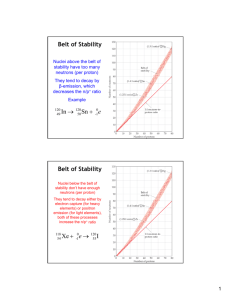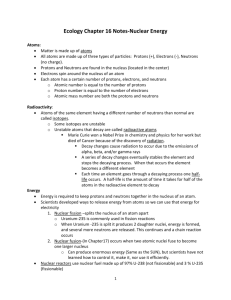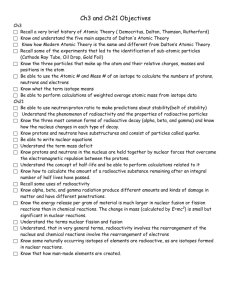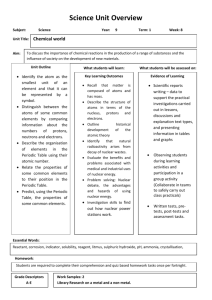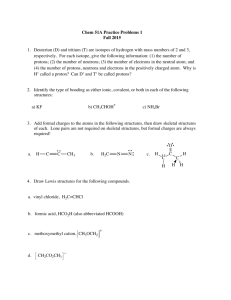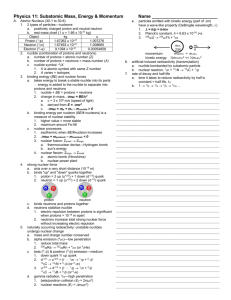Chapter 16 Nuclear Chemistry - An Introduction to Chemistry
advertisement
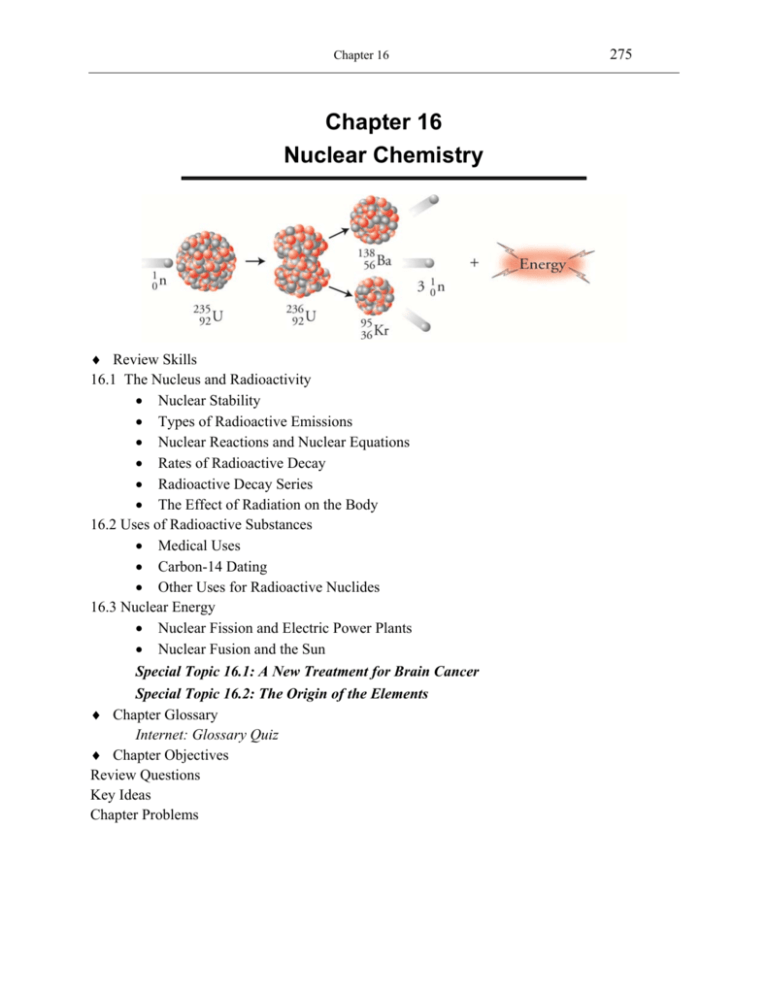
Chapter 16 Chapter 16 Nuclear Chemistry Review Skills 16.1 The Nucleus and Radioactivity Nuclear Stability Types of Radioactive Emissions Nuclear Reactions and Nuclear Equations Rates of Radioactive Decay Radioactive Decay Series The Effect of Radiation on the Body 16.2 Uses of Radioactive Substances Medical Uses Carbon-14 Dating Other Uses for Radioactive Nuclides 16.3 Nuclear Energy Nuclear Fission and Electric Power Plants Nuclear Fusion and the Sun Special Topic 16.1: A New Treatment for Brain Cancer Special Topic 16.2: The Origin of the Elements Chapter Glossary Internet: Glossary Quiz Chapter Objectives Review Questions Key Ideas Chapter Problems 275 276 Study Guide for An Introduction to Chemistry Section Goals and Introductions Section 16.1 The Nucleus and Radioactivity Goals To introduce the new terms nucleon, nucleon number, and nuclide. To show the symbolism used to represent nuclides. To explain why some nuclei are stable and others not. To provide you with a way of predicting nuclear stability. To describe the different types of radioactive decay. To show how nuclear reactions are different from chemical reactions. To show how nuclear equations are different from chemical equations. To show how the rates of radioactive decay can be described with half-life. To explain why short-lived radioactive atoms are in nature. To describe how radiation affects our bodies.. This section provides the basic information that you need to understand radioactive decay. It will also help you understand the many uses of radioactive atoms, including how they are used in medicine and in electricity generation. Section 16.2 Uses of Radioactive Substances Goal: To describe many of the uses of radioactive atoms, including medical uses, archaeological dating, smoke detectors, and food irradiation. Radiation and radioactive substances have often been viewed as dangerous and things that create problems rather than solving them, but there are actually many important and beneficial uses of radioactive atoms. Some of them are described in this section. Section 16.3 Nuclear Energy Goals To describe nuclear fission (the splitting of larger atoms into smaller atoms) and nuclear fusion (the combination of smaller atoms into larger atoms) and to explain why energy is released by each. To describe briefly how nuclear power plants work. To show how the sun gets its energy. The potential energy stored in the nuclei of atoms can be converted into other forms of energy in the fission reactions in nuclear power plants and in the fusion reactions in the sun. This section tells you why this energy conversion takes place. Nuclear power is a major source of energy for electrical generation worldwide. Nuclear power plants are found in over 30 countries and generate a significant percentage of the world’s electricity. This section will help you to understand how these plants work. Chapter 16 Chapter 16 Map 277 278 Study Guide for An Introduction to Chemistry Chapter Checklist Read the Review Skills section. If there is any skill mentioned that you have not yet mastered, review the material on that topic before reading this chapter. Read the chapter quickly before the lecture that describes it. Attend class meetings, take notes, and participate in class discussions. Work the Chapter Exercises, perhaps using the Chapter Examples as guides. Study the Chapter Glossary and test yourself on our Web site: Internet: Glossary Quiz Study all of the Chapter Objectives. You might want to write a description of how you will meet each objective. Memorize the following. Be sure to check with your instructor to determine how much you are expected to know of the following. For the types of radioactive decay, know the symbols, changes in the numbers of protons and neutrons, and changes in the atomic number and mass number described in Table 16.2. To get a review of the most important topics in the chapter, fill in the blanks in the Key Ideas section. Work all of the selected problems at the end of the chapter, and check your answers with the solutions provided in this chapter of the study guide. Ask for help if you need it. Web Resources Internet: Glossary Quiz Exercises Key Exercise 16.1 – Nuclide Symbols: One of the nuclides used in radiation therapy for the treatment of cancer has 39 protons and 51 neutrons. Write its nuclide symbol in the form of AZ X . Write two other ways to represent this nuclide. (Objs 2, 3, & 4) Because this nuclide has 39 protons, its atomic number, Z, is 39. This identifies the element as yttrium. This nuclide of yttrium has 90 total nucleons (39 protons + 51 neutrons), so its nucleon number, A, is 90. 90 90 Y yttrium - 90 39Y Chapter 16 279 Exercise 16.2 – Nuclide Symbols: A nuclide with the symbol 201 Tl can be used to assess a patient’s heart in a stress test. What is its atomic number and mass number? How many protons and how many neutrons are in the nucleus of each atom? Write two other ways to represent this nuclide. (Objs 2, 3, & 4) The periodic table shows us that the atomic number for thallium is 81, so each thallium atom has 81 protons. The superscript in the symbol 201Tl is this nuclide’s mass number. The difference between the mass number (the sum of the numbers of protons and neutrons) and the atomic number (the number of protons) is equal to the number of neutrons, so this nuclide has 120 neutrons (201 – 81). Atomic number = 81 mass number = 201 81 protons 120 neutrons 201 thallium - 201 81Tl Exercise 16.3 - Nuclear Equations: Write nuclear equations for (a) alpha emission by plutonium-239, one of the substances formed in nuclear power plants, (b) beta emission by sodium-24, used to detect blood clots, (c) positron emission by oxygen-15, used to assess the efficiency of the lungs, and (d) electron capture by copper-64, used to diagnose lung disease. (Obj 12) Pu a. 239 94 b. 24 11 Na c. 15 8 O d. 64 29 Cu + 235 92 24 12 15 7 0 1 U + 24 He 0 1 Mg + N + e 0 +1 e e 64 28 Ni Exercise 16.4 - Nuclear Equations: N + He a. 14 7 4 2 b. 238 92 U + c. 238 92 U + 21 H 14 7 N 17 8 Complete the following nuclear equations. (Obj 13) 1 1 O + H 247 99 239 93 Es + 5 01 n Np + 01 n Exercise 16.5 - Half-life: One of the radioactive nuclides formed in nuclear power plants is hydrogen-3, called tritium, which has a half-life of 12.26 years. How long before a sample decreases to 1/8 of its original amount? (Obj 14) In each half-life of a radioactive nuclide, the amount diminishes by one-half. The fraction 1/8 is ½ × ½ × ½, so it takes three half-lives to diminish to 1/8 remaining. Therefore, it will take 36.78 years for tritium to decrease to 1/8 of what was originally there. Exercise 16.6 - Half-life: Uranium-238 is one of the radioactive nuclides sometimes found in soil. It has a half-life of 4.51 × 109 years. What fraction of a sample is left after 9.02 x 109 years? (Obj 15) The length of time divided by the half-life yields the number of half-lives. 9.02 × 109 years = 2 half - lives 4.51 × 109 years Therefore, the fraction remaining would be 1/4 (½ × ½). 280 Study Guide for An Introduction to Chemistry Review Questions Key 1. Describe the nuclear model of the atom, including the general location of the protons, neutrons, and electrons, the relative size of the nucleus compared to the size of the atom, and the modern description of the electron. Protons and neutrons are in a tiny core of the atom called the nucleus, which has a diameter about 1/100,000 the diameter of the atom. The position and motion of the electrons are uncertain, but they generate a negative charge that is felt in the space that surrounds the nucleus. 2. With reference to both their particle and their wave nature, describe the similarities and differences between gamma radiation and radio waves. Which has higher energy? In the particle view, radiant energy is a stream of tiny, massless packets of energy called photons. Different forms of radiant energy differ with respect to the energy of each of their photons. The energies of the photons of radio waves are much lower than for gamma radiation. In the wave view, as radiant energy moves away from the source, it has an effect on the space around it that can be described as a wave consisting of an oscillating electric field perpendicular to an oscillating magnetic field. Different forms of radiant energy differ with respect to the wavelengths and frequencies of these oscillating waves. The waves associated with radio waves have much longer wavelength than the waves associated with gamma radiation. Complete the following statements by writing the word or phrase in each blank that best completes the thought. 3. Atoms that have the same number of protons but different numbers of neutrons are called isotopes. They have the same atomic number but different mass numbers. 4. The atomic number for an atom is equal to the number of protons in an atom’s nucleus. It establishes the element’s identity. 5. The mass number for an atom is equal to the sum of the numbers of protons and neutrons in an atom’s nucleus. 6. Energy is the capacity to do work. 7. Kinetic energy is the capacity to do work due to the motion of an object. 8. The Law of Conservation of Energy states that energy can neither be created nor destroyed, but it can be transferred from one system to another and changed from one form to another. 9. Potential energy is a retrievable, stored form of energy an object possesses by virtue of its position or state. 10. The more stable a system is, the lower (higher or lower) its potential energy. 11. When a system shifts from a less stable to a more stable state, energy is released (absorbed or released). 12. The ground state of an atom is the condition in which its electrons are in the orbitals that give it the lowest possible potential energy. 13. The excited state of an atom is the condition in which one or more of its electrons are in orbitals that do not represent the lowest possible potential energy. Chapter 16 281 Key Ideas Answers 14. Because protons and neutrons reside in the nucleus of atoms, they are called nucleons. 16. There are two forces among the particles within the nucleus. The first, called the electrostatic force, is the force between electrically charged particles. The second force, called the strong force, holds nucleons (protons and neutrons) together. 18. Larger atoms with more protons in their nuclei require a greater ratio of neutrons to protons to balance the increased repulsion between protons. 20. One of the ways that heavy nuclides change to move back into the band of stability is to release two protons and two neutrons in the form of a helium nucleus, called an alpha particle. 22. When a radioactive nuclide has a neutron to proton ratio that is too low, it can move toward stability in one of two ways, positron emission or electron capture. In positron emission (), a proton becomes a neutron and a positron. The neutron stays in the nucleus, and the positron speeds out of the nucleus at high velocity. 24. Because radioactive decay leads to more stable products, it always releases energy, some in the form of kinetic energy of the moving product particles, and some in the form of gamma rays. Gamma rays can be viewed as a stream of high-energy photons. 26. Different isotopes of the same element, which share the same chemical characteristics, often undergo very different nuclear reactions. 28. Nuclear reactions, in general, give off a lot more energy than chemical reactions. 30. Rates of radioactive decay are described in terms of half-life, the time it takes for one-half of a sample to disappear. 32. As alpha particles, which move at up to 10% the speed of light, move through the tissues of our bodies, they pull electrons away from the tissue’s atoms. 34. Gamma photons are ionizing radiation, because they can excite electrons enough to actually remove them from atoms. 36. Because beta particles are smaller than alpha particles, and because they can move up to 90% the speed of light, they are about 100 times as penetrating as alpha particles. 38. Gamma photons that penetrate the body do more damage to rapidly reproducing cells than to others. 40. To date an artifact, a portion of it is analyzed to determine the 14C/12C ratio, which can be used to determine its age. 42. It takes about 10,000 times as much energy to remove a proton or a neutron from the nucleus of a hydrogen-2 atom as to remove its one electron. 44. There appears to be something stable about having 2, 8, 20, 28, 50, 82, or 126 protons or neutrons. The nuclides with double magic numbers have very high stability. 46. For atoms larger than iron-56, splitting larger atoms to form more stable, smaller atoms releases energy. 48. The nuclear reactor in a nuclear power plant is really just a big furnace that generates heat to convert liquid water to steam that turns a steam turbine generator to produce electricity. 282 Study Guide for An Introduction to Chemistry Problems Key Section 16.1: The Nucleus and Radioactivity 50. A radioactive nuclide that has an atomic number of 88 and a mass (nucleon) number of 226 is used in radiation therapy. Write its nuclide symbol in the form of AZ X . Write two other ways to represent this nuclide. (Objs 2 & 4) 226 88 226 Ra Ra radium - 226 52. A radioactive nuclide that has 6 protons and 5 neutrons is used to generate positron emission tomography (PET) brain scans. Write its nuclide symbol in the form of AZ X . Write two other ways to represent this nuclide. (Objs 3 & 4) 11 6 C 11 C carbon - 11 54. A radioactive nuclide with the symbol 40 19 K is used for geologic dating. What is its atomic number and mass (nucleon) number? Write two other ways to represent this nuclide. (Objs 2 & 4) atomic number = 19 mass number = 40 40 K potassium - 40 56. A radioactive nuclide with the symbol 111 49 In is used to label blood platelets. How many protons and how many neutrons does each atom have? Write two other ways to represent this nuclide. (Objs 3 & 4) 49 protons 62 neutrons 111 In indium - 111 58. Barium-131 is used to detect bone tumors. What is its atomic number and mass number? How many protons and how many neutrons are in the nuclei of each atom? Write two other ways to represent this nuclide. (Objs 2, 3, & 4) atomic number = 56 mass number = 131 56 protons 75 neutrons 131 56 Ba 131 Ba 60. The radioactive nuclide with the symbol 75 Se is used to measure the shape of the pancreas. What is its atomic number and mass number? How many protons and how many neutrons are in the nuclei of each atom? Write two other ways to represent this nuclide. (Objs 2, 3, & 4) atomic number = 34 mass number = 75 34 protons 41 neutrons 75 34 Se selenium - 75 Chapter 16 283 62. Describe the two opposing forces between particles in the nucleus, and with reference to these forces, explain why the ratio of neutrons to protons required for a stable nuclide increases as the number of protons in a nucleus increases. (Obj 5) The first force among the particles in the nucleus is called the electrostatic force (or electromagnetic force). It is the force between electrically charged particles. Opposite charges attract each other, and like charges repel each other, so the positively charged protons in the nucleus of an atom have an electrostatic force pushing them apart. The second force, called the strong force, holds nucleons (protons and neutrons) together. You can think of neutrons as the nuclear glue that allows protons to stay together in the nucleus. Because neutrons are uncharged, there are no electrostatic repulsions among them and other particles, but each neutron in the nucleus of an atom is attracted to other neutrons and to protons by the strong force. Therefore, adding neutrons to a nucleus leads to more attractions holding the particles of the nucleus together without causing increased repulsion between those particles. Larger atoms with more protons in their nuclei require a greater ratio of neutrons to protons to balance the increased electrostatic repulsion between protons. 64. Write a general description of the changes that take place in alpha emission. Write the two symbols used for an alpha particle. Write the general equation for alpha emission, using X for the reactant element symbol, Y for the product element symbol, Z for atomic number, and A for mass number. (Objs 6 & 7) One of the ways that heavy nuclides change to move back into the band of stability is to release two protons and two neutrons in the form of a helium nucleus, called an alpha particle. In nuclear equations for alpha emission, the alpha particle is described as either or 24 He . In alpha emission, the radioactive nuclide changes into a different element that has an atomic number that is two lower and a mass number that is four lower. A AZ--42Y + 42 He ZX 66. Write a general description of the changes that take place in positron emission. Write the three symbols used for a positron. Write the general equation for positron emission, using X for the reactant element symbol, Y for the product element symbol, Z for atomic number, and A for mass number. (Objs 6 & 7) In positron emission (+), a proton becomes a neutron and an anti-electron. The neutron stays in the nucleus, and the positron speeds out of the nucleus at high velocity. p n + e In nuclear equations for positron emission, the electron is described as either +, +10 e , or 0 1 e . In positron emission, the radioactive nuclide changes into a different element that has an atomic number that is one lower but that has the same mass number. A ZA- 1Y + +10 e ZX 284 Study Guide for An Introduction to Chemistry 209 215 68. Consider three isotopes of bismuth, 202 83 Bi, 83 Bi, and 83 Bi . Bismuth-209 is stable. One of the other nuclides undergoes beta emission, and the remaining nuclide undergoes electron capture. Identify the isotope that makes each of these changes, and explain your choices. (Obj 8) Bismuth-202, which has a lower neutron to proton ratio than the stable bismuth-209, undergoes electron capture, which increases the neutron to proton ratio. Bismuth-215, which has a higher neutron to proton ratio than the stable bismuth-209, undergoes beta emission, which decreases the neutron to proton ratio. 71. What nuclear process or processes lead to each of the results listed below? The possibilities are alpha emission, beta emission, positron emission, electron capture, and gamma emission. (Obj 6) a. Atomic number increases by 1. beta emission alpha emission b. Mass number decreases by 4. c. No change in atomic number or mass number gamma emission positron emission or electron capture d. The number of protons decreases by 1. beta emission e. The number of neutrons decreases by 1. f. The number of protons decreases by 2. alpha emission 73. Describe the differences between nuclear reactions and chemical reactions. (Obj 10) Nuclear reactions involve changes in the nucleus, as opposed to chemical reactions that involve the loss, gain, and sharing of electrons. Different isotopes of the same element often undergo very different nuclear reactions, whereas they all share the same chemical characteristics. Unlike chemical reactions, the rates of nuclear reactions are unaffected by temperature, pressure, and the other atoms to which the radioactive atom is bonded. Nuclear reactions, in general, give off a lot more energy than chemical reactions. 38 38 74. Explain why 17 Cl and 17 Cl are very different chemically and why they each undergo identical nuclear reactions. These two particles differ only in the number of their electrons. Because chemical reactions involve the loss, gain, and sharing of electrons, the number of electrons for an atom is very important for chemical changes. The attractions between charges are also very important for chemical changes, so the different charges of these particles change how they act chemically. Nuclear reactions are determined by the stability of nuclei, which is related to the number of protons and neutrons in the nuclei. They are unaffected by the number of electrons and unaffected by the overall charge of the particles. Therefore, these particles, which both have 17 protons and 21 neutrons in their nuclei, have the same nuclear stability and undergo the same nuclear changes. 76. Marie Curie won the Nobel Prize for physics in 1903 for her study of radioactive nuclides, including polonium-218 (which was named after her native country, Poland). Polonium-218 undergoes alpha emission. Write the nuclear equation for this change. (Obj 12) 218 84 Po 214 82 Pb + 42 He Chapter 16 285 78. Cobalt-60, which is the most common nuclide used in radiation therapy for cancer, undergoes beta emission. Write the nuclear equation for this reaction. (Obj 12) 60 27 Co 60 28 0 1 Ni + e 80. Carbon-11 is used in PET brain scans because it emits positrons. Write the nuclear equation for the positron emission of carbon-11. (Obj 12) 11 6 C 11 5 0 +1 B + e 82. Mercury-197 was used in the past for brain scans. Its decay can be detected, because this nuclide undergoes electron capture, which forms an excited atom that then releases a gamma photon that escapes the body and strikes a detector. Write the nuclear equation for the electron capture by mercury-197. (Obj 12) 197 80 Hg + 0 1 e 197 79 Au 84. Complete the following nuclear equations. (Obj 13) a. 90 38 Sr b. 17 9 F c. 222 86 d. 18 9 e. 235 92 f. 7 4 g. 52 26 h. 3 1 i. 14 6 j. 118 54 Xe k. 204 84 Po + l. 238 92 U 90 39 17 8 O + Rn F + 0 1 218 84 0 1 0 1 e e Po + 42 He e U Be + 0 1 Y + 18 8 O Th + 42 He 231 90 e Fe 52 25 H 3 2 C 0 1 Li 0 +1 Mn + He + 14 7 7 3 N + 118 53 0 1 e 0 1 e I + e 0 +1 e e 204 83 Bi 234 90 Th + 42 He 86. Silver-117 atoms undergo three beta emissions before they reach a stable nuclide. What is the final product? 117 117 117 117 47 Ag 48 Cd 49 In 50 Sn 88. Tellurium-116 atoms undergo two electron captures before they reach a stable nuclide. What is the final product? 116 116 116 50 Sn 52Te 51 Sb 90. Samarium-142 atoms undergo two positron emissions before they reach a stable nuclide. What is the final product? 142 142 142 60 Nd 62 Sm 61 Pm 92. Bismuth-211 atoms undergo an alpha emission and beta emission before they reach a stable nuclide. What is the final product? 211 20781Tl 207 83 Bi 82 Pb 286 Study Guide for An Introduction to Chemistry 94. Complete the following nuclear equations describing the changes that led to the formation of previously undiscovered nuclides. (Obj 13) 12 6 C a. 246 96 Cm + b. 249 98 Cf + c. 240 95 Am + 42 He d. 252 98 Cf + 16 8 10 5 O B 252 102 263 106 No + 6 01 n Sg + 2 01 n 243 97 257 103 Bk + 01 n Lr + 5 01 n 262 96. In February 1981, the first atoms of the element Bohrium-262, 107 Bh , were made from the bombardment of bismuth-209 atoms by chromium-54 atoms. Write a nuclear equation for this reaction. (One or more neutrons may be released in this type of nuclear reaction.) (Obj 13) 209 83 Bi + 54 24 Cr 262 107 Bh + 01 n 98. Cesium-133, which is used in radiation therapy, has a half-life of 30 years. How long before a sample decreases to 1/4 of what was originally there? (Obj 14) It takes two half-lives for a radioactive nuclide to decay to ¼ of its original amount (½ × ½). Therefore, it will take 60 years for cesium-133 to decrease to ¼ of what was originally there. 100. Phosphorus-32, which is used for leukemia therapy, has a half-life of 14.3 days. What fraction of a sample is left in 42.9 days? (Obj 15) The 42.9 days is three half-lives (42.9/14.3), so the fraction remaining would be 1/8 (½× ½ × ½). 102. Explain why short-lived radioactive nuclides are found in nature. (Obj 16) Although short-lived radioactive nuclides disappear relatively quickly once they form, they are constantly being replenished because they are products of other radioactive decays. There are three long-lived radioactive nuclides (uranium-235, uranium-238, and thorium-232) that are responsible for many of the natural radioactive isotopes. 105. The first six steps of the decay series for uranium-235 consist of the changes alpha emission, beta emission, alpha emission, beta emission, alpha emission, and alpha emission. Write the products formed after each of these six steps. 235 231 231 227 227 223 219 90Th 91 Pa 89 Ac 90Th 88 Ra 86 Rn 92 U 107. In the first five steps of the decay series for thorium-232, the products are 228 228 228 224 220 88 Ra, 89 Ac, 90Th, 88 Ra, and 86 Rn . Identify each of these steps as alpha emissions or beta emissions. alpha, beta, beta, alpha, alpha Chapter 16 287 109. Explain why alpha particles are considered ionizing radiation. (Obj 19) As alpha particles, which move at up to 10% the speed of light, move through the tissues of our bodies, they drag electrons away from the tissue’s atoms. Remember that alpha particles are helium nuclei, so they each have a +2 charge. Thus, as the alpha particle moves past an atom or molecule, it attracts the particle’s electrons. One of the electrons might be pulled toward the passing alpha particle enough to escape, but it might not be able to catch up to the fast moving alpha particle. The electron lags behind the alpha particle and is quickly incorporated into another atom or molecule, forming an anion, and the particle that lost the electron becomes positively charged. The alpha particle continues on its way creating many ions before it is slowed enough for electrons to catch up to it and neutralize its charge. 111. Explain why gamma photons are considered ionizing radiation. (Obj 19) Gamma photons can excite electrons enough to actually remove them from atoms. 113. What types of tissues are most sensitive to emission from radioactive nuclides? Why do radiation treatments do more damage to cancer cells than to regular cells? Why are children more affected by radiation than adults are? (Obj 21) The greatest effect is on tissues with rapidly reproducing cells where there are more frequent chemical changes. This is why nuclear emissions have a greater effect on cancerous tumors with their rapidly reproducing cells and on children, who have more rapidly reproducing cells than adults. 115. Why do you think radium-226 concentrates in our bones? Because both radium and calcium are alkaline earth metals in group 2 on the periodic table, they combine with other elements in similar ways. Therefore, if radioactive radium-226 is ingested, it concentrates in the bones in substances that would normally contain calcium. 117. Why are alpha particles more damaging to tissues when the source is ingested than gamma rays would be? (Obj 24) Alpha and beta particles lose all of their energy over a very short distance, so they can do more damage to localized areas in the body than the same number of gamma photons would. Section 16.2: Uses of Radioactive Substances 118. Describe how cobalt-60 is used to treat cancer. (Obj 25) Cobalt-60 emits ionizing radiation in the form of beta particles and gamma photons. Gamma photons penetrate the body and do more damage to rapidly reproducing cells that others. Typically, a focused beam of gamma photons from cobalt-60 is directed at a cancerous tumor. The gamma photons enter the tumor and create ions and free radicals that damage the tumor cells to shrink the tumor. 288 Study Guide for An Introduction to Chemistry 120. Explain how PET can show dynamic processes in the body, such as brain activity and blood flow. (Obj 27) To get a PET scan of a patient, a solution that contains a positron-emitting substance is introduced into the body. The positrons that the radioactive atoms emit collide with electrons, and they annihilate each other, creating two gamma photons that move out in opposite directions. These photons can be detected, and the data can be computer-analyzed to yield images that show where in the body the radioactive substances collected. Depending on the nuclide used and the substance into which it is incorporated, the radioactive substance will move to a specific part of the body. 122. Describe how carbon-14 (radiocarbon) dating of artifacts is done. (Obj 29) Carbon-14 atoms are constantly being produced in our upper atmosphere through neutron bombardment of nitrogen atoms. 14 1 146 C + 11 H 7 N + 0n The carbon-14 formed is quickly oxidized to form carbon dioxide, CO2, which is converted into many different substances in plants. When animals eat the plants, the carbon-14 becomes part of the animal too. For these reasons, carbon-14 is found in all living things. The carbon-14 is a beta-emitter with a half-life of 5730 years (40 years), so as soon as it becomes part of a plant or animal, it begins to disappear. 14 147 N + 01 e 6C As long as a plant or animal is alive, the intake of carbon-14 balances the decay so that the ratio of 14C to 12C remains constant at about 1 in 1,000,000,000,000. When the plant or animal dies, it stops taking in fresh carbon, but the carbon-14 it contains continues to decay. Thus the ratio of 14C to 12C drops steadily. Therefore, to date an artifact, a portion of it is analyzed to determine the 14C/12C ratio, which can be used to calculate its age. Initially, it was thought that determination of the age of something using this technique would be simple. For example, if the 14C/12C ratio had dropped to one-half of the ratio found in the air today, it would be considered to be about 5730 years old. A 14C/12C ratio of one-fourth of the ratio found in the air today would date it as 11,460 years old (two half-lives). This only works if we can assume that the 14C/12C ratio in the air was the same when the object died as it is now, and scientists have discovered that this is not strictly true. Study of very old trees, such as the bristlecone pines in California, have allowed researchers to develop calibration curves that adjust the results of radiocarbon dating experiments for the variation in the 14C/12C ratio that go back about 10,000 years. These calibration curves are now used to get more precise dates for objects. Chapter 16 289 124. Describe how iridium-192 can be used to find leaks in welded pipe joints. (Obj 31) The radioactive iridium-192 is introduced to the pipe, and the connection is wrapped on the outside with film. If there is a crack in the connection, radiation leaks out and exposes the film. 126. Explain how scientists use radioactive tracers. (Obj 33) Unstable nuclides have been used as radioactive tracers that help researchers discover a wide range of things. For example, incorporating carbon-14 into molecules helped scientists to study many of the aspects of photosynthesis. Because the radiation emitted from the carbon-14 atoms can be detected outside of the system into which the molecules are placed, the changes that involve carbon can be traced. Phosphorus-32 atoms can be used to trace phosphorus-containing chemicals as they move from the soil into plants under various conditions. Carbon-14, hydrogen-3, and sulfur-35 have been used to trace the biochemical changes that take place in our bodies. Section 16.3: Nuclear Energy 128. Explain how the binding energy per nucleon can be used to compare the stability of nuclides. (Obj 35) The greater the strengths of the attractions between nucleons, the more stable the nucleus and the greater the difference in potential energy between the separate nucleons and the nucleus. This is reflected in a greater binding energy per nucleon. 130. Explain why 42 He, 126 C, 168 O, and 20 10 Ne are especially stable. (Obj 37) This can be explained by the fact that they have an even number of protons and an even number of the neutrons. Paired nucleons (like paired electrons) are more stable than unpaired ones. 132. Give two reasons why 168 O is more stable than 158 O . Paired nucleons are more stable than unpaired ones, and oxygen-16 with 8 protons and 8 neutrons would have its nucleons paired. Oxygen-15 with an odd number of neutrons (7) would be less stable. Oxygen-16 also has double magic numbers, making it especially stable. Finally, oxygen-15 has too few neutrons to be stable. 134. Describe how heat is generated in a nuclear power plant. (Obj 40) Heat is generated by the chain reaction of uranium-235, which is initiated by the bombardment of uranium fuel that is about 3% uranium-235. The products are significantly more stable than the initial reactants, so the system shifts from higher potential energy to lower potential energy, releasing energy as increased kinetic energy of the product particles. Higher kinetic energy means higher temperature. 136. Describe the role of the moderator in a nuclear reactor. (Obj 42) Both uranium-235 and uranium-238 absorb fast neutrons, but if the neutrons are slowed down, they are much more likely to be absorbed by uranium-235 atoms than uranium-238 atoms. Therefore, in a nuclear reactor, the fuel rods are surrounded by a substance called a moderator, which slows the neutrons as they pass through it. Several substances have been used as moderators, but normal water is most common. 290 Study Guide for An Introduction to Chemistry 138. Nuclear wastes must be isolated from the environment for a very long time because they contain relatively long-lived radioactive nuclides, such as technetium-99 with a half-life of over 2.1 × 105 years. One proposed solution is to bombard the waste with neutrons so as to convert the long-lived nuclides into nuclides that decay more quickly. When technetium-99 absorbs a neutron, it forms technetium-100, which has a half-life of 16 seconds and forms stable ruthenium-100 by emitting a beta particle. Write the nuclear equations for these two changes. 99 1 10043Tc 43Tc + 0 n Tc 100 43 100 44 Ru + 0 1 e Additional Problems 141. A radioactive nuclide that has an atomic number of 53 and a mass (nucleon) number of 131 is used to measure thyroid function. Write its nuclide symbol in the form of AZ X . Write two other ways to symbolize this nuclide. 131 131 I iodine - 131 53 I 143. A radioactive nuclide that has 11 protons and 13 neutrons is used to detect blood clots. Write its nuclide symbol in the form of AZ X . Write two other ways to symbolize this nuclide. 24 24 Na sodium - 24 11 Na 145. A radioactive nuclide with the symbol 133 55 Cs is used in radiation therapy. What is its atomic number and mass (nucleon) number? Write two other ways to represent this nuclide. atomic number = 55 mass number = 133 133 Cs cesium - 133 51 147. A radioactive nuclide with the symbol 24 Cr is used to determine blood volume. How many protons and neutrons does each atom have? Write two other ways to represent this nuclide. 24 protons 27 neutrons 51 Cr chromium - 51 149. Gallium-67 is used to diagnose lymphoma. What is its atomic number and mass number? How many protons and how many neutrons are in the nuclei of each atom? Write two other ways to represent this nuclide. 67 atomic number = 31 mass number = 67 31 protons 36 neutrons 67 Ga 31 Ga 151. The radioactive nuclide with the symbol 32 P is used to detect eye tumors. What is its atomic number and mass number? How many protons and how many neutrons are in the nuclei of each atom? Write two other ways to represent this nuclide. atomic number = 15 mass number = 32 15 protons 17 neutrons 32 15 P phosphorus - 32 Chapter 16 291 18 20 24 153. Consider three isotopes of neon, 10 Ne, 10 Ne, and 10 Ne . Neon-20, which is the most abundant isotope of neon, is stable. One of the other nuclides undergoes beta emission, and the remaining nuclide undergoes positron emission. Identify the isotope that makes each of these changes, and explain your choices. Neon-18, which has a lower neutron to proton ratio than the stable neon-20, undergoes positron emission, which increases the neutron to proton ratio. Neon-24, which has a higher neutron to proton ratio than the stable neon-20, undergoes beta emission, which decreases the neutron to proton ratio. 155. Write the nuclear equation for the alpha emission of bismuth-189. 189 18581Tl + 24 He 83 Bi 157. Phosphorus-32, which is used to detect breast cancer, undergoes beta emission. Write the nuclear equation for this reaction. 32 0 32 15 P 16 S + 1 e 159. Write the nuclear equation for the positron emission of potassium-40. 40 40 18 Ar + +10 e 19 K 161. Radioactive selenium-75, used to determine the shape of the pancreas, shifts to a more stable nuclide via electron capture. Write the nuclear equation for this change. 75 0 75 33 As 34 Se + 1 e 163. Germanium-78 atoms undergo two beta emissions before they reach a stable nuclide. What is the final product? 78 78 78 34 Se 32 Ge 33 As 165. Iron-52 atoms undergo one positron emission and one electron capture before they reach a stable nuclide. What is the final product? 52 52 52 26 Fe 25 Mn 24 Cr 167. Arsenic-69 atoms undergo one positron emission and one electron capture before they reach a stable nuclide. What is the final product? 69 69 69 33 As 32 Ge 31 Ga 170. Complete the following nuclear equations. 15 1 259 a. 249 98 Cf + 7 N 105 Db + 5 0 n b. 249 98 c. 121 51 Cf + 10 5 B Sb + 11 H 257 103 Lr + 2 01 n Te + 01 n 121 52 172. Nitrogen-containing explosives carried by potential terrorists can be detected at airports by bombarding suspicious luggage with low-energy neutrons. The nitrogen-14 atoms absorb the neutrons, forming nitrogen-15 atoms. The nitrogen-15 atoms emit gamma photons of a characteristic wavelength that can be detected outside the luggage. Write a nuclear equation for the reaction that forms nitrogen-15 from nitrogen-14. 14 1 157 N 7 N + 0n 292 Study Guide for An Introduction to Chemistry 174. In March 1984, the nuclide hassium-265, 265 108 Hs , was made from the bombardment of lead-208 atoms with iron-58 atoms. Write a nuclear equation for this reaction. (One or more neutrons may be released in this type of nuclear reaction.) 208 58 1 265 82 Pb + 26 Fe 108 Hs + 0 n 176. Krypton-79, which is used to assess cardiovascular function, has a half-life of 34.5 hours. How long before a sample decreases to 1/8 of what was originally there? It takes three half-lives for a radioactive nuclide to decay to 1/8 of its original amount (½ × ½ × ½). Therefore, it will take 103.5 hours (104 hours to three significant figures) for krypton-79 to decrease to 1/8 of what was originally there. 178. Iron-59, which is used to diagnose anemia, has a half-life of 45 days. What fraction of it is left in 90 days? The 90 days is two half-lives (90/45), so the fraction remaining would be 1/4 (½ × ½).
